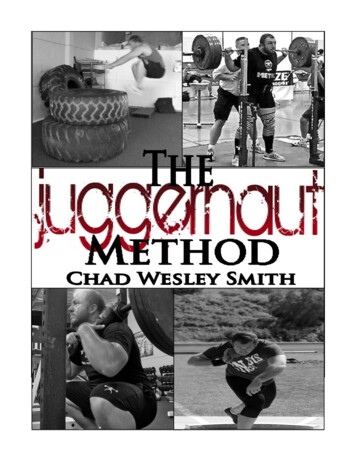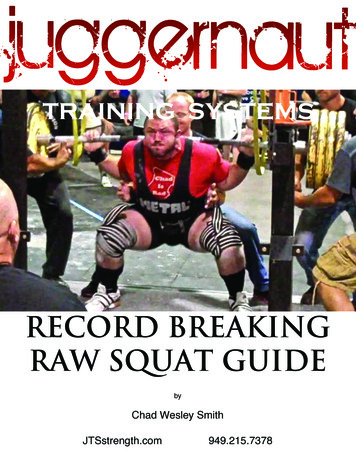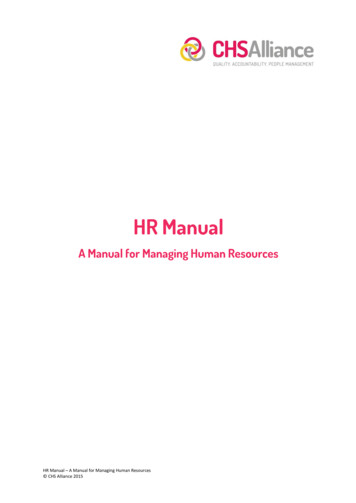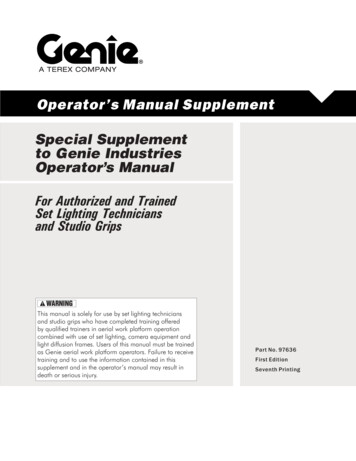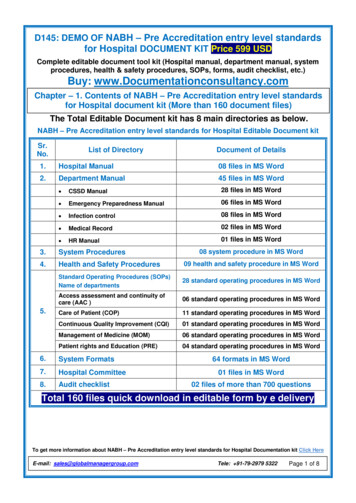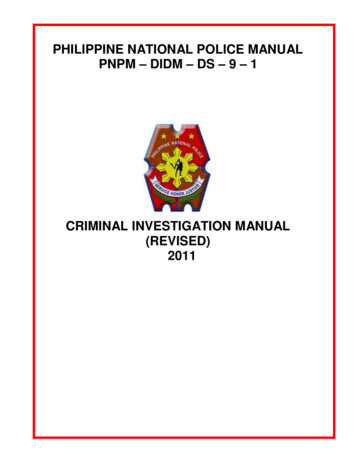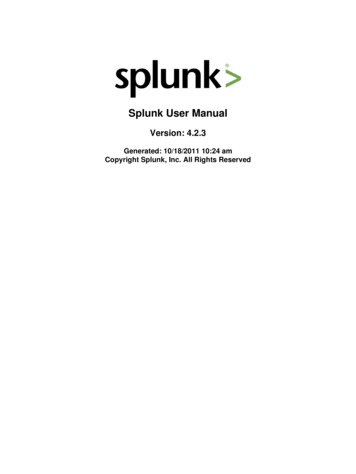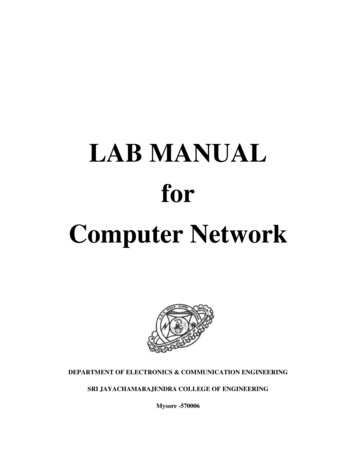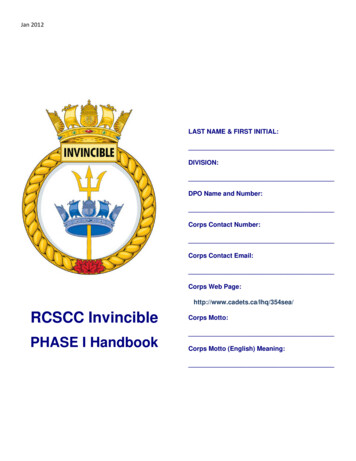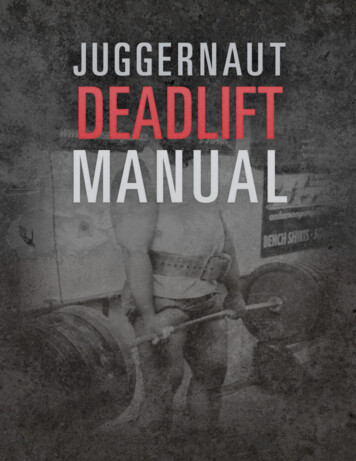
Transcription
JUGGERNAUT DEADLIFT MANUAL1
JUG G E R N AU TDEADLIFTM A NUA LB ECO ME U N STO P PA B LEbyJUGGERNAUT DEADLIFT MANUALTEAM JUGGERNAUT2
TABL E OF C O N T E N T SINTRODUCTI ON4TEN STEP DE ADL I FT WAR M- UP6DEADLIFT TI P S AND TR I CKS15BUILDING THE DE ADL I FT20TRAINING THE CAR DEADL I FT24DEADLIFT F OR OLYMP I C L I FTI NG28DEADLIFT S FOR WOMEN’S P HYSI Q U E32THE DEADLI FT’S R OL E I N P OWE R D EV ELO P MEN T35THOUGHTS ON DEADL I FT TR AI NI N G39SUM O DEADLI FT42JUGGERNAUT DE ADL I FTI NG45JUGGERNAUT DEADLIFT MANUAL3
I NT R OD U C T IO NBY CHAD WESLEY SMITHThe deadlift is often referred to as the King of Exercises because itdevelops so many muscles in the body and is so grueling toperform. Team Juggernaut is comprised of some of the World’sgreatest deadlifters including 5 lifters who have deadlifted 800 ineither competition or training. This manual was created to help youconquer your deadlift training. The deadlift, more so than any othercompetitive lift, confounds people who are trying to improve itbecause the approaches needed for success vary so greatly fromperson to person. Some people need to pull heavy every week toimprove, while others only need to use heavy weights once a monthto make gains. In this manual you will hear a variety of opinions froma variety of athletes with varying experience, strengths, weaknesses,goals and body types and while everyone will have somethingdifferent to offer you when it comes to improving your pull, there area few things that must exist no matter what, consistency andcommitment. To be a legendary deadlifter you can’t have a month ofgood training and then a fewweeks of sub par work, you can’tWorld Record Holder Dan Green, the owner of a 821deadlift, knows the hard work necessary to be agreat deadlifter.JUGGERNAUT DEADLIFT MANUAL4
even have months on end of great training followed by a month ofsubstandard work; being a great deadlifter is a labor of years ofsweat, bloody shins and torn apart hands. You must commit to yourgoals, knowing that nothing can deny you. The deadlift is just youand the bar, who is going to win?JUGGERNAUT DEADLIFT MANUAL5
T EN S TE PS D E A D L IF T WARMU PBY RYAN BROWNRyan Brown is the owner and head coach at Darkside Strength/Derby City Crossfit inLouisville, KY. A former Marine, Ryan is now an expert in mobility and correctiveexercise, as well as performance enhancement. Ryan’s best deadlift is 530 at 185pounds. Learn more about Ryan at Darkside.DCcrossfit.comHere at DCCF and Darkside Strength, everyone pulls. If you areunable to achieve a good position in the bottom of a deadlift thenwe will force you into a good position. You will pull off pins or boxes,maybe you will do band pull throughs, KB deadlifts, or suitcasedeadlifts, but some sort of lower body pull will be a major part ofyour program. Point is, every human should possess the ability to liftthings off the ground, and if you can’t, then your program should bewritten with the goal of achieving that ability.When warming up for the deadlift, I take different considerationsthan I do when warming up for other movements. Since the deadliftis so taxing, I want to have a decent sweat going at the end of mywarm-up, so that I can take less reps as I work up to my workingweight for the day. I want to focus less on gaining the length that Imay need in olympic lifting, or even in squatting and instead placethe focus on putting all my bits in the optimal position to produceforce. More stiffness is going to be your friend in the deadlift.As with warming anything up, what you need is going to be largelyspecific on your individual strengths, weaknesses, asymmetries,JUGGERNAUT DEADLIFT MANUAL6
jankiness, etc., but let’s try and hit on the major ones that I see inthe gym regularly.CLICK HERE TO WATCH RYAN’S VIDEO REVIEWING THE WARM-UPFEETTripod foot. Ideally, as you pull your foot is creating a rigid “tripod”with your 1st metatarsal, 5th metatarsal, and your heel. Weightwould be evenly distributed across the three points and give you asolid and stable base with which to drive into the floor. Fairly often Isee people in the gym fail to achieve this position. It seems thatwhen the lifter pulls he is driving his tibia into the floor pronating hisfoot, thus “bleeding” force out through the inside of the knee, ratherthan keeping it neutral. Sometimes that can result in knee pain,sometimes not, but regardless of pain it is not going to be anoptimal position to translate force. If you fall into that category, youmay need to look into better footwear for your deadlift. More oftenthan not, something funky is going on with your hips that needs tobe corrected before you are going to be able to get that foot right.KNEESAre your knees caving on your heavy pulls? There could be a coupleof problems here. More often than not, it is a result of your hipsbeing anteriorly tilted, thus making the posterior muscles too longand creating instability. It could be the result of weak glutes orhamstrings, but first, make sure to assess your setup positionbefore you regard it as a weakness. Hint: always pay attention toyour foot position.JUGGERNAUT DEADLIFT MANUAL7
H IP SIf you do not possess sufficient mobility in your hips to get down ina deadlift position, then you don’t need to worry about warming upfor your deadlift. You need to get yourself right, because if you don’thave hip mobility for a deadlift then you don’t have it for a squat andyou don’t really have a reason to live.H IP F L E X O R S / L OW E R A B SI do not see a lot of people wanting to stretch the hip flexors beforea big deadlift, which is a good thing because they probably don’tneed it. What they need (more than likely) is to be “turned on” andstrengthened. If you are one of those people who is living in lumbarextension and anterior pelvic tilt then you are going to want toaddress this in your warm-up. Getting your hips into a neutralposition is going to be key to getting the maximum amount of powerfrom your hamstrings and your glutes, as well as being able tomaintain a neutral spine.SP IN EBREATHE!!!!! If you can’t get your spine into a neutral position thenyour sweet little baby muscles that are in close to the spine, that aresupposed to give it stability, are going to be out of position andunable to do the job. You may still achieve spinal stability but youare going to do so with the wrong muscles. It is not only inefficient,but not so awesome for your back either. If you are more of a flat tspine guy with a huge anterior tilt, then you are going to do betterwith breathing drills designed to help you use your air to push yourJUGGERNAUT DEADLIFT MANUAL8
T-spine out from the inside. If you are more kyphotic then you will doa little better with some breathing drills on your back. Just thinkabout using your breathe to make you longer and decompress yourspine. Done right, this will also help you correct your hip & shoulderposition and set you up for big pulls.SH O U L D E R SHopefully the breathing is going to give you good t-spine position,which will give you good scapular position and stability, which will,in turn, keep your shoulders in a good position. However, if you arenot all the way there, or if you are not living in this good position,some activation exercises can help get these often weak,overstretched muscles back in the game.NECKOnce again, hopefully the breathing drills have already started to getyour neck back over your center of mass where it belongs, but ifyou tend to have a forward head posture with weak or inhibiteddeep neck flexors, this is another area where some chin tucks andwhatnot will be your friend. I know that there are different ideasabout deadlifting with your head up vs. chin tucked. I tend to havemy people keep their chin tucked during the deadlift in the attemptto make on long spine. This will make it much easier to get a big fullbreathe as well as prevent your body for compensating for the bigextension in your neck with your T-spine, pulling your shoulders upand inhibiting your middle and lower traps (which can be useful in adeadlift. using them, not inhibiting). Inhibiting your deeper neckflexors is also going to cause your SCM and scalenes to provide theJUGGERNAUT DEADLIFT MANUAL9
stability in your neck. by tugging down on it while it is in extension,probably creating some sheer force. I know that there is a ton ofcontroversy with where you should “look” while doing deadlifts,olympic lifts, or squatting, so these are just some ideas to thinkabout. I am well aware that with heavy deadlifts your back is goingto round and your head will probably come up, if not, I am sure thatyou would just do more, but that doesn’t mean that we should notstart and strive to maintain optimal position throughout.SAM PLE WAR M- UP1 . ) MO N O S T R U C T U R A L M OV E M E N TThis is the most simple and basic aspect of the warm-up. Thepurpose is to literally begin the warm-up process. Low amplitude,low intensity movements aimed at increasing the temperature andblood flow to the body.It can be anything, a row, a jog, jump rope, etc. but for the deadliftI like a 5-10min sled drag. This can be just walking, or you can getmore specific if you have and idea of your own asymmetries andimbalances. As always with sled walking/dragging, I want to befocusing now on getting my breathing right.2 . ) F OA M RO L L I N GI like to give myself a light roll all over. If I have the time, I will startoff with a lacrosse ball in my foot and work my wall all the way up.Obviously, I spend a little more time working any particular areasthat need it. I know there is a ton of info out on the internet sayingthat you can foam roll too much, and that you shouldn’t roll someJUGGERNAUT DEADLIFT MANUAL10
things, but this is a really great time for me to drink assault orMonster and run my mouth to the other people in the gym, so I likemaking this a lengthy portion of the warm-up. Focus on what youneed individually, think of areas that are inhibited and are going tolimit your ability to maintain a good position. Popular areas couldinclude; feet (arch too high?), peroneals (pulling foot eversion?)adductors (knees pull in?), pecs (excessive kyphosis?) or traps/middle/lower/rhomboids (t-spine stuck in ext?)3 . ) B R E AT H E4 . ) AC T IV E WA R M U PLarge amplitude, low velocity movements aimed at further increasingtemperature and blood flow, but also working joints through largeranges of motion taking advantage of the freedom we just gainedfrom our SMR. Could be walking lunges, t-pushups, walking hipexternal rotation, good mornings, upper body pulling variations5 . ) J O IN T M O B I L I T Y / L E N G T H E N I N GAs we said earlier we aren’t really doing much lengthening workbefore deadlifting, if you are too tight to achieve a good deadliftposition then you have more problems than warming up yourdeadlift. Here we do want to take this opportunity to make sure andmore the major joints through their full range of motion. I like tokeep it pretty simple. Hip circles, pass throughs with pvc or bands,step overs (front, back, lateral) and O’s on an incline bench aresome of my favoritesJUGGERNAUT DEADLIFT MANUAL11
6 . ) DY N A M I CHere we are going to use large amplitude movements that start toadd some velocity. No need to do anything fancy, leg swings (front/back,side/side) arm swings, power skip, butt kick, high knees,carioca, etc.7 . ) BA R WA R M - U PHere I like to add in a little more velocity with some more technicalmovements which is going to create a higher demand forintermuscular coordination, furthering the body’s overallpreparedness. At my gym, most everyone has “some” olympic liftingskills. Which works out perfectly for a deadlift warmup. I like to justhit 10 deadlift, 10 hang power clean, 10 hang power snatch, and 10push jerk. If you are horrible at OLY lifting then you might want toskip this step, or it can be a chance to practice some new skills.Brad Little is a technician ofthe sumo deadlift asevidenced by his US #1ranked pull of 730 at 181bodyweight.JUGGERNAUT DEADLIFT MANUAL12
8 . ) MU S C L E AC T I VAT I O NThis is another aspect of the warm-up that needs to be specialized.I idea is to use very controlled movements and positions in order toplace emphasis on muscles or groups that could be inhibited onyou. It is very important to remember that this is muscle activation,not exhaustion. You shouldn’t be doing 3 sets of 10 or anything likethat. Depending on your needs some good options here wouldinclude; lateral band walks, glute bridges, I,Y,T,W,O shoulder mobseries, pull throughs, band pull aparts, face pulls, scap pullups, wallpress abs, supine psoas march.9 . ) P LYONearing the end of the warm-up now we are looking maximizing thevelocity of our movements in order to create the highest demand forintramuscular coordination in the body. These can be jumps, throws,or olympic lifts if you are proficient. If you are taking the Oly routeyou are going to need to lift near maximal weights, in order toachieve the velocity needed, but you will need to manipulate theintensity with position (hang/power) so that the lifts do not takeaway from your deadlift.1 0 . ) R E AC T I V EThese can be depth jumps, reactive throws, or sometimes with mykids (I have several high school kids) we will play dodge ball, freezetag, or something to that effect. They are fun and a great reactivewarm-up drill. The reactive drills are meant to put everythingtogether and be the most challenging for both inter andJUGGERNAUT DEADLIFT MANUAL13
intramuscular coordination. The final phase in preparing your bodyfor a big pull.JUGGERNAUT DEADLIFT MANUAL14
Dan Green is the World Record holder for Total at220 pounds with a 2030 in just a belt and wraps.Dan’s best deadlift is 821, to go along with hisD E ADL IF T T IPS A N D T RI C K S760 squat (belt and sleeves) and 480 bench.Learn more about Dan at BossBarbell.comBY TEAM JUGGERNAUTJUGGERNAUT DEADLIFT MANUAL1
perform. Team Juggernaut is comprised of some of the World’s greatest deadlifters including 5 lifters who have deadlifted 800 in either competition or training. This
